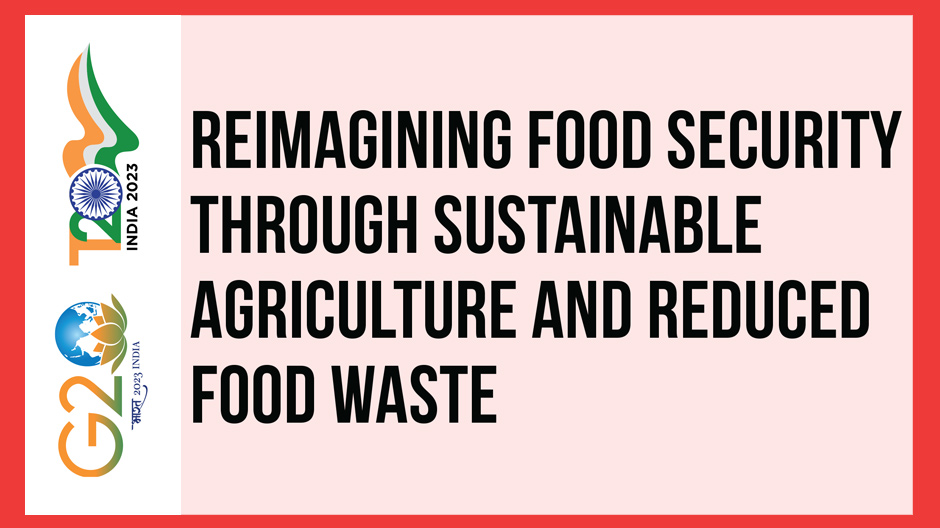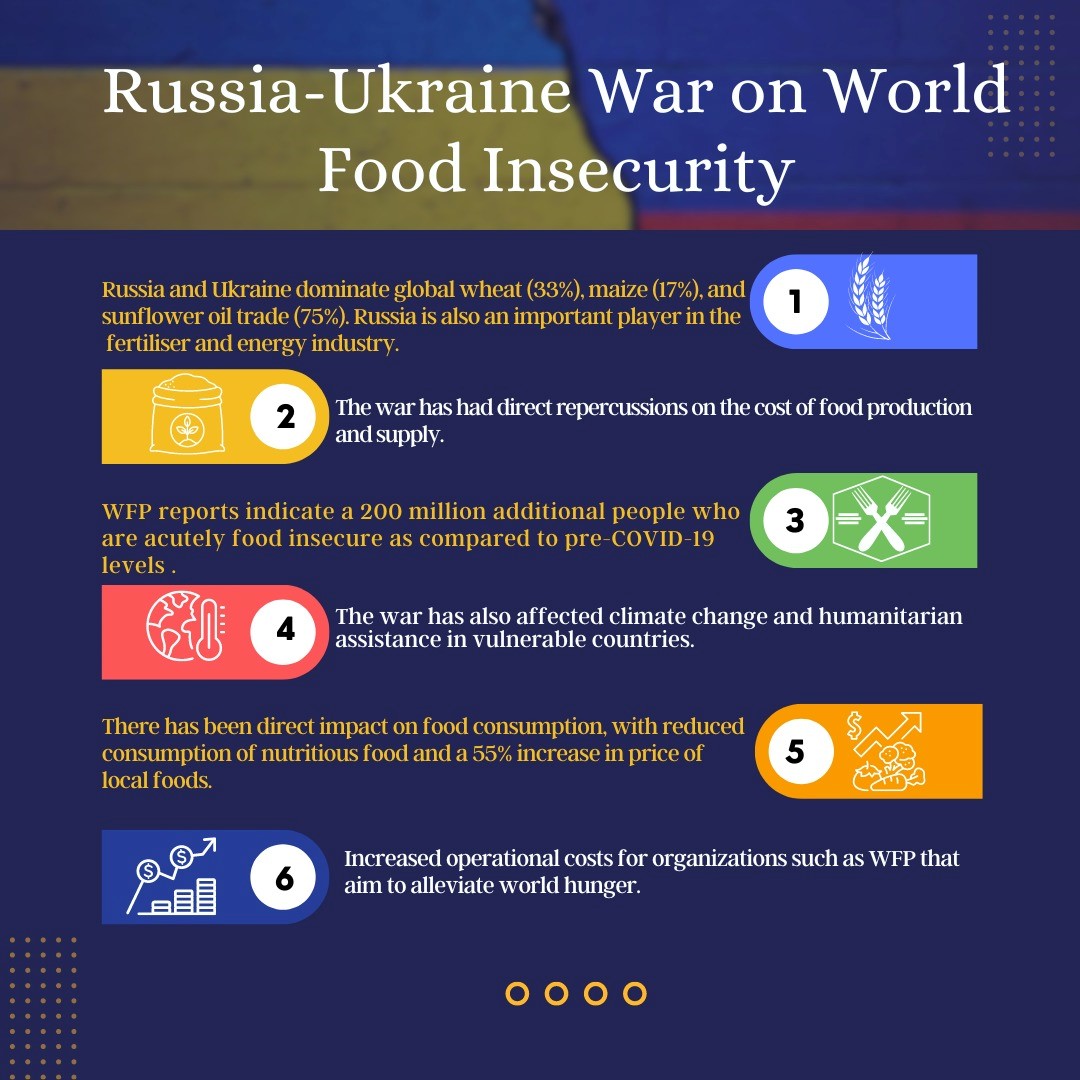Task Force 6: Accelerating SDGs—Exploring New Pathways to the 2030 Agenda
In recent years, the concept of food security has come to be associated with sustainability. In this context, it is pertinent to focus on goals 2 and 12 of the Sustainable Development Goals (SDGs), which specifically aim to reduce hunger and ensure sustainable consumption and production patterns. This policy brief aims to determine ways to de-escalate hunger globally. SDG-2 is important as it calls for a redesigning of food systems through sustainable agriculture and endeavours to provide farmers with a greater role in the production process. SDG-12 focuses on fostering sustainable production and consumption practices, with a particular emphasis on minimising global food waste. Therefore, this brief proposes the establishment of a G20 food bank and a shift towards sustainable agricultural practices. This approach will help preserve the capacity of the land and other resources to produce adequate food for all, reduce food wastage through the redistribution of surplus food, and ensure food security on a global scale.
1. The Challenge
Food security is a critical issue that must be addressed. Amidst the climate crisis and population growth, current food systems[1] are already dysfunctional and incapable of feeding the entire world population. In the present scenario, the world is grappling with the dual problem of a growing population and inefficient use of scarce resources. It is estimated that by 2050, the world population would exponentially rise to 9.8 billion.[2] This growth demands the production of food on a larger scale; however, unsustainable agri-food practices will further threaten natural resources.
On the other hand, one-third of the food, around 1.3 billion tonnes, suitable for human consumption is lost or wasted across the entire food supply chain.[3] This wasted food accounts for 8–10 percent of global greenhouse gas (GHG) emissions, thus accelerating climate crisis and consequently resulting in greater food insecurity.[4] Instead if this food can be saved, it can be used to feed 1.26 billion people annually.[5] Furthermore, recent shocks, specifically the COVID-19 pandemic (see Figure 1) and the Russia-Ukraine war (see Figure 2), created severe economic uncertainty with disrupted global agri-food value chains and substantially pressured agricultural output, which resulted in food price volatility and exacerbated global food insecurity.[6] All these factors combined negatively affect sustainable food production and distribution while escalating food prices and posing a dire threat to global food security.[7]
Figure 1: Impact of COVID-19 on Food Security
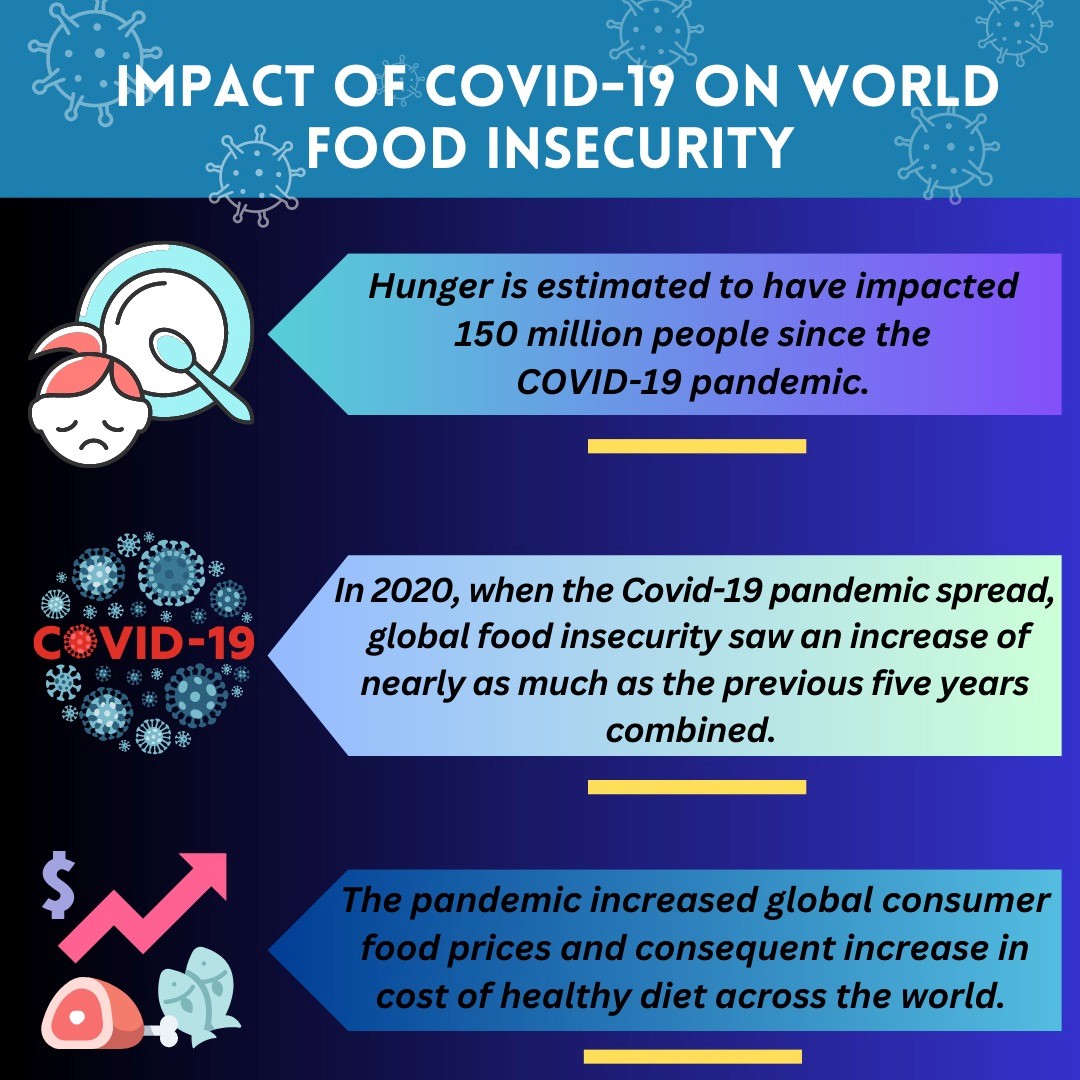
Source: Based on data from FAO[8]
2. The G20’s Role
The G20 leaders have committed to protect the most vulnerable populations from hunger. They pledge to utilise all available tools to tackle the global food crisis, foster the transformation of food systems to contribute to climate-change adaptation and mitigation, and accelerate efforts to reduce food loss and waste (FLW).[11] They also recently committed to taking urgent actions to prevent hunger and malnutrition, and specifically address the vulnerabilities of developing countries by building sustainable and resilient agri-food systems.[12] Additionally, repurposing existing agricultural supports for creating incentives for both producers and consumers became a key instrument in the transition towards sustainable and resilient food systems.[13] As a result, designing policy implications is critical to address global food insecurity, especially for vulnerable groups, covering both producers and consumers.
The international community has been stepping up its engagement in reducing FLW by expanding on policy advice, capacity building, and financing, but further action is needed. A G20-wide collective action to scale up the efforts to reduce FLW would be very useful to increase awareness of sustainable and resilient food systems. With that aim, the G20 Food Bank can be established and executed as a global food bank to save food suitable for human consumption from being wasted, while reducing the effect of food insecurity by serving as a safety net for vulnerable groups.
G20 countries have a greater role in improving food security by encouraging public-private partnerships (PPPs), investments in agriculture and rural development, technological advancements and capacity building. PPPs involve collaboration between government agencies, private companies and civil society organisations to address social, economic and environmental challenges.
The G20 can assist in providing farmers with digital technologies and access to information on markets, weather and best practices, helping them make informed decisions about planting, harvesting and selling crops. Further, capacity building can be taken up by training and educating smallholder farmers, government officials and private sector actors to help build their knowledge and skills in sustainable agriculture, market access and supply chain management. G20 countries can promote policy coherence across sectors and levels of government to ensure that public policies and regulations are aligned with efforts to provide food security. They can also help farmers and others adopt agro-ecological farming practices that protect the biodiversity, conserve natural resources and increase the resilience of food systems. Governments can also support using renewable energy sources in agriculture by providing tax incentives and regulations to incentivise sustainable agriculture practices. Additionally, governments can collaborate with private sector organisations to develop sustainable supply chains that support smallholder farmers.
3. Recommendations to the G20
Establishing a G20 food bank
The proposed G20 food bank will mainly collect and store food and food products, and then distribute them to people in need. Hence, volunteer food manufacturers and distributors, restaurants and the hospitality sector, government commodities, grocery retailers, and consumers can “deposit” food in the “bank”, and people in need would “withdraw it from the bank” (see Figure 3). In this way, the food bank creates a circular approach to the current food system and makes it more resilient and sustainable while fighting food insecurity in society. For instance, the world’s three largest food bank networks—the European Food Banks Federation, Feeding America and the Global Food Banking Network—reported that, in 2019, around 3.75 million metric tonnes of food, equivalent to approximately 1,292 Olympic swimming pools of food, were successfully recovered.[14] In other words, such a colossal level of FLW can be effectively minimised by diverting food surplus to food banks.
Figure 3: The Structure of a Food Bank
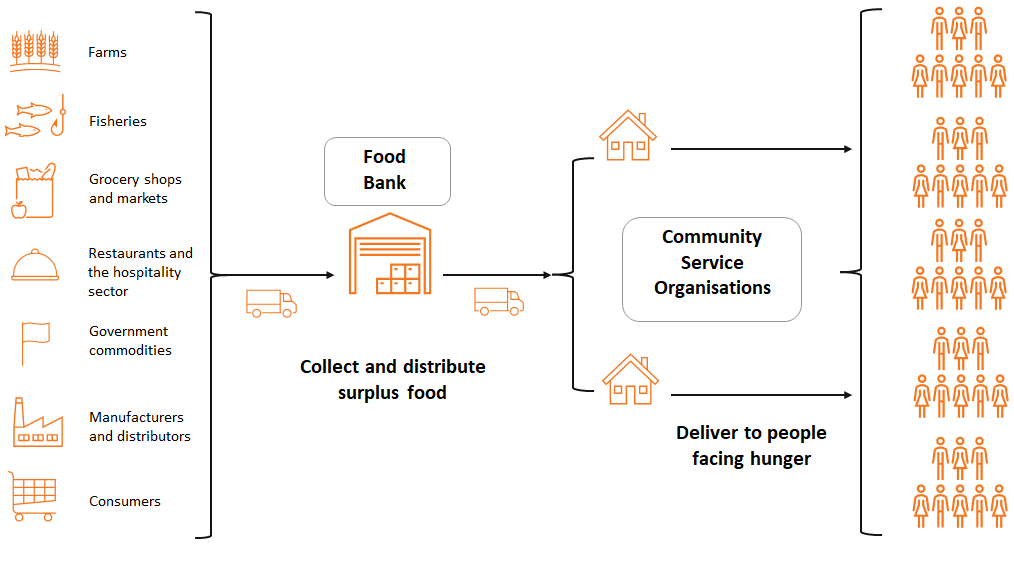
Source: The Global Food Banking Network[15]
Table 1: Examples of food banks in Select G20 countries
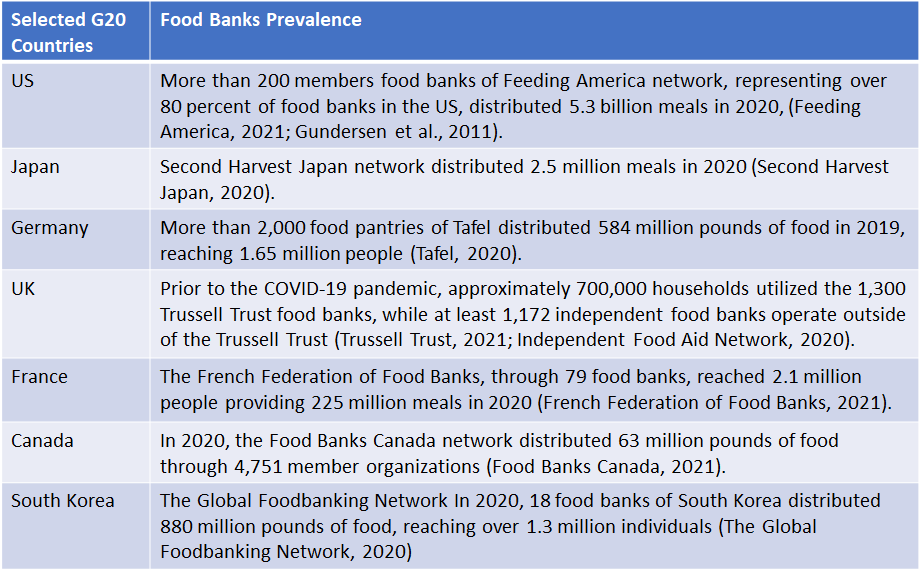
Source: Byrne and Just[17]
- It has the potential to change individual and even societal behaviour towards reducing FLW.
- It will help combat the environmental impacts of agri-food systems[18] and prevent redundant waste of natural resources, such as freshwater.[19]
- It can serve as leverage to create a mass movement for responsible consumption.
- It can foster local, regional and global solidarity efforts by increasing awareness about FLW and food security.
- It can contribute to promoting circular economies and fostering community resilience through collective efforts.
- It fits in perfectly with the goals of SDG-2 and SDG-12.
Potential Challenges
- Frame and define an effective working mechanism for the infrastructure, planning and coordination of this bank.
- Address organisational and operational issues, such as establishing well-furnished warehouses with cold storage facilities; enabling the collection, storage, sorting, packing and delivery of rescued food; finding more affordable and environmentally friendly logistics; launching common web-based platforms and mobile apps for digitalisation; and providing human resources to prevent potential operational disruptions due to a lack of volunteers,
- Overcome concerns of people in need who reportedly experience stigma, embarrassment, frustration, and shame while accessing a food bank as they are often delivered food that is left over or unsold, and past the best-before date.[20]
- Assess the illusion of functionality and efficiency projected by disguising the dysfunctionality of current food systems and the long-term food deprivation of vulnerable groups.
Although food banks play a crucial role in reducing food waste and providing assistance to vulnerable populations, relying solely on their establishment may not be sufficient to effectively address the pressing issue of food security. Therefore, our subsequent recommendation complements the proposal for the establishment of the G20 food bank, accentuating the significance of ensuring short-term food security as a safety net to protect vulnerable groups from experiencing food deprivation. By combining both recommendations, current food systems can be transformed by making them more resilient, equitable, fair and sustainable.
Implementing sustainable agriculture practices
This brief proposes implementing sustainable agriculture practices through a five-step process (see Figure 4).
Figure 4: Sustainable Agricultural Practices
Step 1: Soil conservation techniquesBy putting soil preservation methods into practice, such as crop rotation, cover crops, mulching and reduced tillage, there can be a substantial improvement in soil quality and erosion and boost agricultural output. For instance, in India, the use of cover crops like legumes has helped to improve soil fertility, reduce soil erosion and increase crop yields, especially in rain-fed areas,[23] while in Australia, the use of zero tillage in dryland farming has helped to reduce soil erosion, conserve soil moisture and improve soil structure, leading to increased crop yields and reduced water use.[24] Reduced tillage can help the health of the soil by greatly reducing soil erosion. Reduced ploughing, in accordance with the FAO, can improve water infiltration by up to 50 percent, decrease soil erosion by up to 60 percent and boost soil organic matter by up to 30 percent.[25]
Step 2: Integrated Pest Management strategies
Integrated Pest Management (IPM) strategies (such as biological control,[26] cultural practices and prudent pesticide use) can lessen the environmental impact pesticides. In Kenya, using the larval parasitoid Cotesia flavipes as a biological control agent to manage maize stemborer has resulted in reduced pesticide use and enhanced farmer livelihoods.[27] IPM has also decreased the use of pesticides and improved plant quality as well as reduced GHG emissions in Europe.[28]
Step 3: Diversifying crop and livestock production systems
By diversifying crop and livestock production systems, biodiversity and resilience can be enhanced, which can boost the agricultural output and encourage environmental sustainability. Agroforestry, intercropping and mixed farming are common methods to diversify both crop and livestock production systems.[29] For example, adapting agroforestry has improved soil fertility and the availability of food and fuelwood in Cameroon,[30] while increasing farmers’ income, decreasing soil erosion and restoring degraded land in Indonesia.[31]
Step 4: Water-efficient agriculture systems
Water is a valuable and scarce natural resource that complements the production capacity of land. Israel has been successfully using drip irrigation since the 1970s, where it has increased crop yields by cutting down water consumption by up to 70 percent and improved the quality of its produce.[32] Another example is mulching in Zimbabwe,[33] where maize grain yield rose by 17.2 percent and 26.3 percent in the third and fourth seasons, respectively. Mulching also increased soybean production by 42 percent in Zimbabwe.
Step 5: Promoting renewable sources of energy
Utilising renewable energy in agricultural practices contributes to mitigating climate change, improving energy security, increasing access to energy and supporting economic growth. Agrarian practices heavily rely on fossil-fuel–based energy, making it essential to ensure farmers’ access to modern, affordable, and sustainable energy for sustainable agricultural practices. Ground-mounted renewable power plants offer a stable source of income for a period of 25 years, even from uncultivable under-utilized land.
As solar pumps and small-scale solar electricity plants receive subsidies in India,[34] more than 3.5 million Indian farmers will now have access to clean energy. Decreasing solar module cost makes solar pumps a viable option for farmers and holds great potential to save 4 billion litres of diesel annually and 5 percent of total GHG emissions. Besides, in the sub-Saharan region, a new generation of agricultural equipment powered by off-grid solar energy is being created for small-holder farmers. The United National Environment Program estimates that every 10 percent increase in farm yield has led to a 7 percent decrease in poverty in Africa.32
Attribution: Alok Kushwaha et al., “Reimagining Food Security Through Sustainable Agriculture and Reduced Food Waste,” T20 Policy Brief, July 2023.
Endnotes
[1] HLPE, “Food Security and Nutrition: Building a Global Narrative Towards 2030,” Report 15, High-level Panel of Experts, Food Security and Nutrition, World Food Security, (Rome, 2020): 11.
[2] United Nations Department of Economic and Social Affairs , “World Population Prospects 2022: Summary of Results,” UN, 2022.
[3] Food and Agriculture Organization, “Global Food Losses and Food Waste: Extent, Causes and Prevention,” Rome, FAO, 2011.
[4] “Tackling Food Loss and Waste: A Triple Win Opportunity,” FAO, September 29, 2022.
[5] FAO, “Tackling food loss and waste”
[6] Pavlo Martyshev, Oleg Nivievskyi, and Mariia Bogonos, “Regional War, Global Consequences: Mounting Damages to Ukraine’s Agriculture and Growing Challenges for Global Food Security,” IFPRI Blog: Guest Post, March 27, 2023.
[7] Bjoern Rother et al., “Tackling the Global Food Crisis: Impact, Policy Response, and the Role of the IMF,” IMF Notes, September 29, 2022.
[8] Food and Agriculture Organization of the United Nations, International Fund for Agricultural Development, UNICEF, World Food Programme, and World Health Organization, “The State of Food Security and Nutrition in the World 2022: Repurposing food and agricultural policies to make healthy diets more affordable,” Chapter 2, Rome, FAO, IFAD, UNICEF, WFP and WHO, 2022.
[9] Caitlin Welsh, “Russia, Ukraine, and Global Food Security: A One-Year Assessment,” Center for Strategic & International Studies, February 24, 2023.
[10] World Food Programme, “War in Ukraine drives global food crisis,” June 24, 2022.
[11] G20 Italia 2021, “Matera Declaration on Food Security, Nutrition and Food Systems. A Call to Action in the Time of the Covid-19 Pandemic and Beyond,” 2021.
[12] G20 Indonesia, “G20 Bali Leaders’ Declaration,” November 16, 2022.
[13] Will Martin et al., “G20 Framework for Repurposing Agricultural Policy Support to Meet Global Climate and Food Security Goals,” T20 Policy Brief, 2022.
[14] “Reducing Food Loss and Waste,” The Global Food Banking Network, accessed April 20, 2023.
[15] “Starting a Food Bank: Understanding Food Banking: Toolkit 1,” The Global Food Banking Network, October 1, 2021.
[16] Nistha Dubey and Ajinkya Tanksale, “A Study of Barriers for Adoption and Growth of Food Banks in India Using Hybrid DEMATEL and Analytic Network Process,” Socio-Economic Planning Sciences 79 (2022): 101124.
[17] Anne T. Byrne and David R. Just, “Private Food Assistance in High Income Countries: A Guide for Practitioners, Policymakers, and Researchers,” Food Policy 111 (2022): 102300.
[18] Tamar Makov, Alon Shepon, Jonathan Krones, Clare Gupta, and Marian Chertow, “Social and Environmental Analysis of Food Waste Abatement Via the Peer-to-Peer Sharing Economy,” Nature Communications, 11, Article number: 1156 (2020): 1–8.
[19] Josemi G. Penalver and Maite M. Aldaya, “The Role of the Food Banks in Saving Freshwater Resources through Reducing Food Waste: The Case of the Food Bank of Navarra, Spain,” Foods 11, 163 (2022): 1–15.
[20] Céline Giner and Olivia Placzek, “Food insecurity and food assistance programmes across OECD countries: Overcoming evidence gaps,” OECD Food, Agriculture and Fisheries Papers, No. 183, (2022).
[21] Alexander Wezel et al., “Agroecological practices for sustainable agriculture. A review,” Agronomy for sustainable development 34, no. 1 (2014): 1-20.
[22] Miguel A. Altieri, Agroecology: The Science of Sustainable Agriculture (Florida: CRC Press, 2018), 205–349.
[23] Andy Clark, ed., “Managing Cover Crops Profitably (3rd ed.),” Sustainable Agriculture Research and Education, 2008.
[24] Sarina MacFadyen, “It’s Zero-till, but Not as We Know It,” Australian Centre for International Agricultural Research (ACIAR), May 17, 2019.
[25] Jefline Kodzwa, Jephita Gotosa, and Justice Nyamangara, “Mulching Is the Most Important of the Three Conservation Agriculture Principles in Increasing Crop Yield in the Short Term, under Sub Humid Tropical Conditions in Zimbabwe,” Soil and Tillage Research, 197 (2020): 104515.
[26] J.C. van Lenteren et al., “Assessing Risks of Releasing Exotic Biological Control Agents of Arthropod Pests,” Annual Review of Entomology 51, no. 1 (2006): 609–34.
[27] Nanqing Jiang et al., “Host–Parasitoid Community Model and Its Potential Application in Biological Control of Cereal Stemborers in Kenya,” Population Ecology 50 (2008): 405–416.
[28] Virginia Sánchez-Navarro et al., “Does the Use of Cowpea in Rotation with a Vegetable Crop Improve Soil Quality and Crop Yield and Quality? A Field Study in SE Spain,” European Journal of Agronomy, 107, 2019: 10–17.
[29] Olivier Duchene, Jean-François Vian, and Florian Celette, “Intercropping with Legume for Agroecological Cropping Systems: Complementarity and Facilitation Processes and the Importance of Soil Microorganisms: A Review,” Agriculture, Ecosystems & Environment 240 (2017): 148–161.
[30] Ernest L. Molua, “The Economics of Tropical Agroforestry Systems: The Case of Agroforestry Farms in Cameroon,” Forest Policy and Economics 7, no. 2 (2005): 199–211.
[31] Erwin Soetirto, “Policy on Livestock Development in Indonesia,” Proceedings of the Third Regional Meeting of the Forages for Smallholders Project (1998): 29-36.
[32] Girma Megersa and Jemal Abdulahi, “Irrigation System in Israel: A Review,” International Journal of Water Resources and Environmental Engineering 7, no. 3 (2015): 29–37.
[33] Jefline Kodzwa, J. Gotosa, and Justice Nyamangara, “Mulching Is the Most Important of the Three Conservation Agriculture Principles in Increasing Crop Yield in the Short Term, under Sub Humid Tropical Conditions in Zimbabwe,” Soil and Tillage Research, 197 (2020): 104515.
[34] “Tata Power Solar: Solar Pumps and PM KUSUM Scheme,” TATA Power Solar, last modified 2023.



